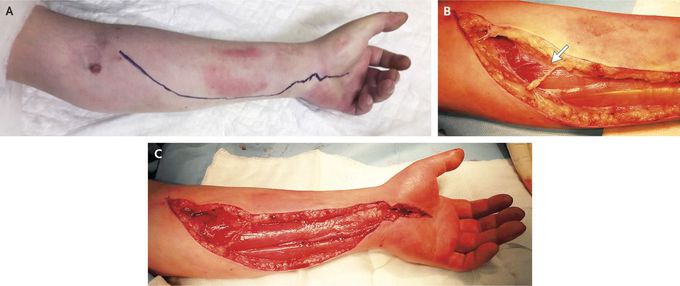


Compartment Syndrome
A 26-year-old man presented to the emergency department with a painful, swollen left hand (Panel A). He had been lying on the ground for more than 13 hours after using illicit drugs. The physical examination revealed edema in the left hand and forearm. Active and passive motion of the hand was limited by pain. Sensation was diminished in distributions of the median, ulnar, and radial nerves. Capillary refilling was delayed; the ulnar pulse was palpable, but the radial pulse was undetectable. Laboratory analyses revealed a creatine kinase level of 21,500 U per liter (normal range, 38 to 309). Emergency surgical decompression under tourniquet control showed a demarcation between perfused muscle fibers and ischemic, pale, noncontractile muscle (Panel B, arrow). Perfusion was restored after decompression and release of the tourniquet (Panel C). The compartment syndrome occurs after crush trauma injury or prolonged immobilization, as in this patient. Prompt surgical decompression is critical to reperfuse ischemic muscles and nerves in the compartment. However, even delayed decompression, as in this case, may have the potential to restore perfusion, although full recovery of nerves and muscles may be limited. A second operation that was performed 48 hours after the first procedure showed viable muscle tissue, and the wound was covered with a split-thickness skin graft. The patient did not participate in recommended hand therapy, and hand stiffness and paresthesia persisted. He was subsequently lost to follow-up. Aileen F. Egan, M.B., B.A.O., M.Ch. Kevin C. Cahill, M.D. St. James’s Hospital, Dublin, Ireland source: nejm.org
What was the illicit drug that the patient took prior to this condition?

